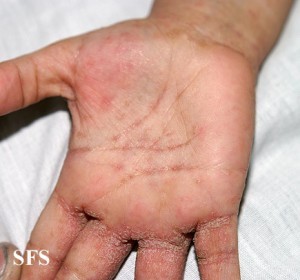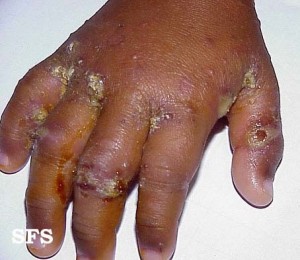Scabies Skin Infestation (Children, Adults) Pictures, Treatment
Scabies is a well known skin problem that is caused by a tiny mite (insect). It is often thought to be associated with poverty, poor personal hygiene and living in an unhygienic environment. However, this is not the case. Any person of any socioeconomic status can get scabies and personal hygiene is not a factor. Children and the elderly are the most prone for several reasons. Around 300 million cases of scabies are reported throughout the world every year. While it is more common in developing nations, outbreaks of scabies occurs in industrialized nations occur every now and then. It is therefore important to understand how scabies affects humans and the ways to prevent it.
What is scabies?
Scabies is a skin disease caused by the scabies mite, Sarcoptes scabiei hominis. This is just one of the many types of skin bugs that infests the human skin. In severe cases bacteria can sometimes cause a secondary skin infection. The symptoms of scabies like itchy skin and a skin rash are due to an allergic reaction to the mite, and not from bites. The scabies mite is limited to the skin and does not penetrate deeper into the body to cause other internal diseases.
Overall scabies is easy to treat and prevent. It spreads easily among people in close contact and especially in a home, or daycare center, nursing home, hospital or in crowded living conditions. Even in these cases it can be effectively treated, although most close contacts have to be treated simultaneously as the person with scabies. There is a type of scabies that is known as crusted scabies which is very contagious and difficult to treat. It is mainly seen in people with weakened immune systems, like in HIV infection, and among the elderly.
Human Scabies, Pets and Wild Animals
The scabies mite, Sarcoptes scabiei hominis, specifically affects humans and is a variety of the Sarcoptes family of mites. Other varieties can infest other animals, including dogs, pigs, horses and a range of wild animals. It is rare for the scabies mites that infests animals to also infest human skin. However, it is possible. When it does occur, scabies in humans is usually temporary and mild compared to the human scabies mites. This type of scabies presentation is referred to as atypical. It usually does not require any treatment.
Causes of Scabies
Scabies is caused by the scabies mite. The mite burrows into human skin and lays its eggs within these tracks. It is the body’s allergic response to the mite and eggs that gives rise to the symptoms of scabies. There are usually between 10 to 15 adult female mites living on a person with scabies. Mites are tiny but visible to the naked eye.
Direct and Indirect Spread
The human scabies mite completes its entire life cycle on the host, in this case humans. However, it can live on bedding and clothing for a period of 2 to 3 days. Environmental temperature does make a difference. The scabies mite becomes immobile at temperatures below 20ºC. These factors are important to consider in the prevention of scabies and eradication of the mite within the home environment.
The adult mite has 4 pairs of legs and cannot fly or jump. Therefore skin-to-skin contact or indirect contact with objects (fomites) where the scabies mite (adult female mite) can live is required for transmission. However, momentary contact may not spread the mites. There has to be direct or indirect contact for a long period of time to allow the mite to crawl from one person to another.
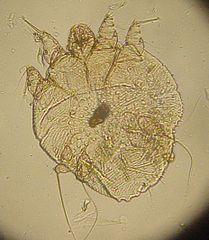
Life Cycle
- Adult female mite has proteolytic (digestive) enzymes to penetrate the surface of the skin and form burrows.
- The eggs are deposited within the S-shaped burrow made by the female and hatch within 3 to 4 days.
- The newly-hatched larvae then comes up on to the skin surface and finds unaffected skin to form new shorter burrows.
- These larvae then mature within these new burrows which are also know as molting pouches.
- The larvae molt into nymphs which then molt into larger nymphs and subsequently become adult mites.
- Male and female mites mate just once and the male mite dies after mating.
- These adult females will lay around 60 to 90 eggs within their 30 day (sometimes up to 60 days) lifespan. Only 10% of these eggs will hatch into larvae.
Risk Factors
Although it is known that scabies is caused by the Sarcoptes mite that has a predilection for humans, the exact reason why it affects some people and not others is not always clear. It is now known that scabies is not associated with poor hygiene or unhealthy living conditions. However, there are socioeconomic factors that may increase the risk of scabies as it is associated with crowded living conditions and sharing of clothing and bedding.
Nevertheless scabies can affect people who are more affluent. Certain age groups are more likely to be affected irrespective of socioeconomic status. This includes:
- Children due to outbreaks within daycare centers and schools.
- Elderly, particularly those who live in nursing homes.
- Women, particularly mothers, due to close contact with children with scabies.
It is important to note that transmission can also occur among sexual partners due to close contact. It is being considered as a sexually transmitted disease although the mite is more often spread with skin-to-skin contact without sexual contact. Sleeping on the same bed as a person with scabies, even without sexual contact, greatly increases the chances of infestation.
Scabies Symptoms
The two main symptoms of scabies is severe itching, which is typically worse at night, and tiny red ‘spots’ on the skin. These spots appear as tiny bumps or blisters on the skin. This is known as the classical presentation. The scalp, face, neck, palms of the hands and soles of the feet are commonly affected sites in children. Usually the rash appears on the skin folds, including:
- Armpits
- Shoulder blades
- Elbows
- Wrists
- Breasts
- Waist
- Genitalia (males)
- Knees
- Soles of the feet
These symptoms may arise only after 4 to 6 weeks of being infested with scabies mites. Severe redness, swelling, oozing discharge and tenderness or pain in the skin are more likely symptoms of a secondary bacterial infection which requires prompt treatment. Staphylococci or streptococci are the most common bacteria to cause a superficial skin infection (impetigo). In crusted scabies the skin rash tends to be crusted and scaly. It occurs over large parts of the body.
Scabies Pictures
The following images were sourced from the Dermatology Atlas.
Pictures of the scabies skin rash
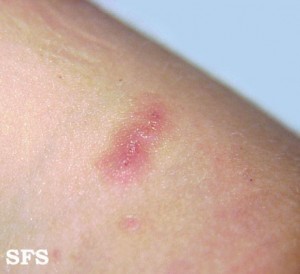
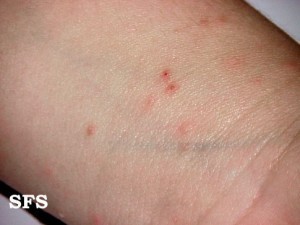
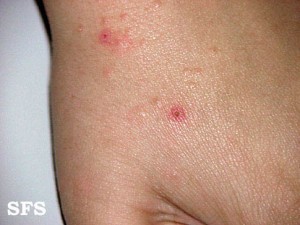
Picture of scabies on the palm
Picture of scabies on a baby
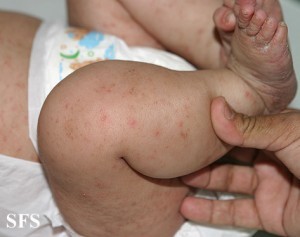
Picture of scabies with secondary bacterial infection
Scabies Treatment
Several conservative measures can be used to reduce the symptoms. This includes soaking in cold water or apply cold applications to the skin, applying calamine lotion to relieve itching and taking antihistamines. However, none of these measures will kill the mite, destroy its eggs and eradicate it entirely. Other medication (discussed below) may be needed for these purposes.
Permethrin 5%
- Kills the mites and is most commonly prescribed medication for scabies.
- Safe for pregnant and breastfeeding women, children of all ages and adults.
Lindane
- Similar to permethrin in that it kills the mites (scabicidal).
- Not safe for children younger than 2 years, pregnant women or immune compromised people.
Crotamiton
- Less commonly used for scabies as it may not kill all mites.
- Used more often for babies with scabies.
Ivermectin
- Oral medication – taken through the mouth.
- For crusted scabies, people with weak immune systems or people who do not respond to other scabies medication.
Eradicating The Mite
The medication mentioned above are very effective in destroying the mites and eggs on human skin and eventually eradicating scabies. However, other measures should also be utilized during this time particularly for mites that may be living on inanimate objects (fomites) within the home, like in clothing and bed linen. In fact these measures will ensure that a recurrence of the scabies infestation does not occur.
The clothing and bed linen should be washed frequently with hot soapy water. Towels and any other items that are shared should also be washed. High heat should be used to dry the items. If there are any items that cannot be washed, then it should be placed in an air-tight bag for about one week. This essentially starves the mites.
Remember that cold may make the mite inactive but will not kill it. Always ensure that people in close contact with the scabies patient are also treated, particularly siblings, parents and other people living in the same home.
References:
emedicine.medscape.com/article/1109204-overview#aw2aab6b2b2
my.clevelandclinic.org/disorders/scabies/hic_scabies.aspx
www.mayoclinic.org/diseases-conditions/scabies/basics/treatment/con-20023488

